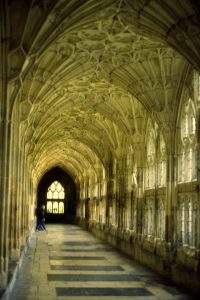 Gloucester Cathedral in England was a monastic church in 1392 which plays a role in Memento Mori, the third novel in my Lady Apollonia West Country Mysteries. In the 14th century, the present cathedral was the Abbey of Saint Peter which was the most important monastic house in Gloucester. Lady Apollonia visited the abbey in my story, but as a woman and someone outside the religious house, she was not able to visit the cloister and the chapter house which I will discuss in this posting.
Gloucester Cathedral in England was a monastic church in 1392 which plays a role in Memento Mori, the third novel in my Lady Apollonia West Country Mysteries. In the 14th century, the present cathedral was the Abbey of Saint Peter which was the most important monastic house in Gloucester. Lady Apollonia visited the abbey in my story, but as a woman and someone outside the religious house, she was not able to visit the cloister and the chapter house which I will discuss in this posting.
The abbey was Benedictine and in the Norman period had a cloister for the monks on the south side of the church as was typical of monastic layout. That was replaced with a new cloister to the north of the church, begun with construction of the east walk during the tenure of Abbot Thomas Horton from 1351 to 1377. The other three sides of the new cloister were built under Abbot Walter Frocester from 1381 to 1412. It is uncertain how much of this had been completed by 1392. The west cloister walk is shown to the left. Small-scale fan vaults had been attempted early on, but the first full-scale structural fan vaulting was developed in this cloister.
The east walk includes a Norman door giving access to the chapter house which is older than the cloister. It also provided access to the dorter or dormitory and the east slype of the abbey. The north walk includes a lavatorium where the monks washed but in medieval times provided access to the monks’ refectory. The south walk, next to the church, provides twenty carrels or study booths for the monks use.
The chapter house was built in the Norman period as a place for the monks to meet with the abbot to receive instructions and transact business as well as gather to read each day a chapter of Saint Benedict’s Rule. Originally the chapter house had an apsidal end where the abbot sat, but it was remodelled several times during the medieval period. Any Norman windows on the east side were replaced with Gothic windows by the time of my story.
The cloister walks have been used in modern times for several films and TV series including parts of Hogwarts School in three Harry Potter movies. They have also appeared in the Doctor Who, Hollow Crown, Wolf Hall, and Sherlock TV series.
Tags: Chaucer's England, historical fiction, medieval mysteries